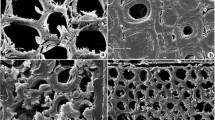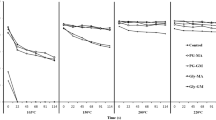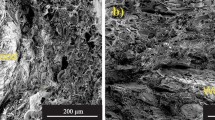Abstract
Wood polymer composites were investigated using aqueous solutions of polyglycerol methacrylate (PGMA), obtained from polyglycerol an agricultural by-product of the diester industry and glycidyl methacrylate, in order to improve the properties of the material. Treated blocks possess increased dimensional stability compared to untreated ones. The relationships between experimental conditions (PGMA concentration, curing temperature, addition of low molecular weight vinyl monomer) and performance of treated wood were investigated. Biological tests carried out using Coriolus versicolor, a white rot fungus, on beech blocks and Poria placenta, a brown rot fungus, on pine blocks demonstrated protection by chemical modification. Such an approach, using renewable starting materials and water-borne treatments, constitutes an attractive alternative to conventional preservation procedures using broadly active biocides.
Zusammenfassung
Es wurde eine Untersuchung von Verbundmaterial aus Holz und Polyglycerinmethacrylat (PGMA) durchgeführt. Die Polymerkomponente wurde aus Polyglycerin, einem Nebenprodukt der landwirtschaftlichen Diester-Industrie, und Glycidylmethacrylat hergestellt. Die Behandlung erfolgt in wäßrigem Medium. Im Vergleich zu unbehandeltem Holz besitzen die behandelten Blöcke eine erhöhte Formstabilität. Der Zusammenhang zwischen experimentellen Bedingungen (PGMA-Konzentration, Temperatur während der Behandlung, Beimengung von Vinylmonomeren mit niedriger Molmasse) und den Eigenschaften des behandelten Holzes wurden untersucht. Die biologischen Tests, die mit Kulturen von Coriolus versicolor, einem weißen Fäulnispilz, an Buchen-Blöcken, und parallel mit Poria placenta, einem braunen Fäulnispilz, an Kiefern-Blöcken durchgeführt wurden, zeigen, daß das behandelte Holze ausgezeichnet gegen Pilzbefall geschützt ist. Diese Art der Holzbehandlung mit Produkten aus der Biomasse in wäßrigem Medium stellt eine attraktive Alternative zu konventionellen Methoden dar, die auf dem Einsatz von Breitband-Bioziden beruhen.




Similar content being viewed by others
References
Barnes HM, Murphy RJ (1995) Wood preservation. The classics and the new age. Forest Prod J 45(9):16–23
Doss NL, Elawady MM, Elawady NI, Mansour SH (1991) Impregnation of white pine wood with unsaturated polyesters to produce wood-plastic combinations. J Appl Polym Sci 42(9):2589–2594
Fujimara T, Inoue M, Vemura I (1990) Durability of wood with acrylic-high-pomymer. Dimensional stability with crosslinked acrylic copolymer in wood. Mokuzai Gakkaishi 36(10):851–859
Hoffmann P (1988a) On the stabilization of water logged oakwood in polyethyleneglycol (PEG) II. Designing a two step treatment for multiquality timbers. Studies Conservat 31:103–113
Hoffmann P (1988b) On the stabilization of water logged oakwood in polyethyleneglycol (PEG) III. Testing the oligomers. Holzforschung 42(5): 289–294
Hoffmann P (1990) On the stabilization of water logged oakwood in polyethyleneglycol (PEG) IV. Species from China and Corea. Holzforschung 44(2): 87–93
Meyer JA (1984) Wood-polymer materials in chemistry of solid wood. Adv Chem Series 257–289
Nakano T (1994) Reaction of glyoxal and glyoxal/glycol with wood. Wood Sci Technol 28:23–33
Rowell RM (1984) Penetration and reactivity of cell wall components in chemistry of solid wood. Adv Chem Series 175–210
Schneider MH (1994) Wood polymer composites. Wood Fiber Sci 26(1):142–151
Stamm AJ (1959) Effect of polyethyleneglycol on the dimensional stability of wood. Forest Prod J 9:375–381
Stamm A J (1965) Factors affecting bulking and dimensional stability of wood. Forest Prod J 14:403–408
Suttie E (1997) Novel wood preservatives. Chem Ind 18:720–724
Van Dijk-Wolthuis WNE, Franssen, Talsma OH, van Steenbergen MJ, Kettenes-van den Bosch JJ, Hennink WE (1995) Synthesis, characterization, and Polymerization of glycidyl methacrylate derivatized Dextran. Macromol 28(18):6317–6322
Van Dijk-Wolthuis WNE, Kettenes-van den Bosch JJ, van der Kerk-van Hoof A, Hennink WE (1997) Reaction of Dextran with glycidyl methacrylate: an unexpected transesterification. Macromol 30(11):3411–3413
Yasuda R, Minato K (1995) Chemical modification of wood by non formaldehyde cross-linking reagents. Wood Sci Technol 29:243–251
Acknowledgements
This work was supported by Ademe (Agence de l’Environnement et de la Maîtrise de l’Energie), Agrice (Agriculture pour la Chimie et l’Energie) and Onidol (Organisation Nationale Interprofessionnelle des Oléagineux).
Author information
Authors and Affiliations
Corresponding author
Rights and permissions
About this article
Cite this article
Soulounganga, P., Loubinoux, B., Wozniak, E. et al. Improvement of wood properties by impregnation with polyglycerol methacrylate. Holz Roh Werkst 62, 281–285 (2004). https://doi.org/10.1007/s00107-004-0485-y
Published:
Issue Date:
DOI: https://doi.org/10.1007/s00107-004-0485-y




